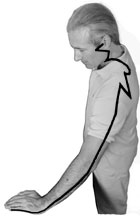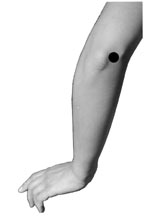 Muscle Testing Rectus Femoris - Associated with the Small Intestine Meridian |
| When a muscle has been identified as strong, a further differentiation must be used to determine if this muscle is hypertonic or normotonic. In AK, a normotonic muscle is defined as one which is strong, but is perceived as weakening when one of the following procedures is used: a) TL* to the sedation point of the meridian associated with that muscle, on the side of the muscle being tested.
|
|
b) >running the meridian in reverse<: |
 The Small Intestine Meridian flows from little finger nail to in front of the ear. To weaken, stroke backwards from ear to little finger. |
|
c) Spindle Cell Manipulation: |
  Spindle Cell Manipulation to Weaken Rectus Femoris |
|
d) Either of the two poles of a strong, axially polarized magnet (minimum 2000 gauss), centrally placed upon the belly of the muscle. Regarding the effects of the N and S pole of magnets on the strength of muscles, seemingly contradictory responses have been observed. If none of the above methods causes weakening of the muscle, it is defined as hypertonic. It is recommended that at least two of the above procedures be used when evaluating the status of a muscle. |
| * Experience has shown that TL (touch while testing the muscle or tapping before testing the muscle) to the related sedation point to be the most reliable of the four techniques described above. - Ed. |

